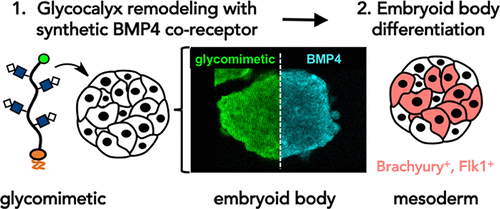当前位置:
X-MOL 学术
›
ACS Chem. Biol.
›
论文详情
Our official English website, www.x-mol.net, welcomes your
feedback! (Note: you will need to create a separate account there.)
Embryonic Stem Cell Engineering with a Glycomimetic FGF2/BMP4 Co-Receptor Drives Mesodermal Differentiation in a Three-Dimensional Culture
ACS Chemical Biology ( IF 3.5 ) Pub Date : 2018-08-29 00:00:00 , DOI: 10.1021/acschembio.8b00436 Matthew R. Naticchia 1 , Logan K. Laubach 1 , Ember M. Tota 1 , Taryn M. Lucas 1 , Mia L. Huang 1 , Kamil Godula 1
ACS Chemical Biology ( IF 3.5 ) Pub Date : 2018-08-29 00:00:00 , DOI: 10.1021/acschembio.8b00436 Matthew R. Naticchia 1 , Logan K. Laubach 1 , Ember M. Tota 1 , Taryn M. Lucas 1 , Mia L. Huang 1 , Kamil Godula 1
Affiliation

|
Cell surface glycans, such as heparan sulfate (HS), are increasingly identified as co-regulators of growth factor signaling in early embryonic development; therefore, chemical tailoring of HS activity within the cellular glycocalyx of stem cells offers an opportunity to control their differentiation. The growth factors FGF2 and BMP4 are involved in mediating the exit of murine embryonic stem cells (mESCs) from their pluripotent state and their differentiation toward mesodermal cell types, respectively. Here, we report a method for remodeling the glycocalyx of mutant Ext1–/– mESCs with defective biosynthesis of HS to drive their mesodermal differentiation in an embryoid body culture. Lipid-functionalized synthetic HS-mimetic glycopolymers with affinity for both FGF2 and BMP4 were introduced into the plasma membrane of Ext1–/– mESCs, where they acted as functional co-receptors of these growth factors and facilitated signal transduction through associated MAPK and Smad signaling pathways. We demonstrate that these materials can be employed to remodel Ext1–/– mESCs within three-dimensional embryoid body structures, providing enhanced association of BMP4 at the cell surface and driving mesodermal differentiation. As a more complete understanding of the function of HS in regulating development continues to emerge, this simple glycocalyx engineering method is poised to enable precise control over growth factor signaling activity and outcomes of differentiation in stem cells.
中文翻译:

胚胎模拟干细胞工程与拟态的FGF2 / BMP4共同受体驱动三维培养中的中胚层分化。
细胞表面聚糖,例如硫酸乙酰肝素(HS),在早期胚胎发育中被越来越多地确定为生长因子信号转导的共调节因子。因此,化学修饰干细胞的细胞糖萼内的HS活性提供了控制其分化的机会。生长因子FGF2和BMP4分别参与介导鼠胚胎干细胞(mESCs)从其多能状态向着中胚层细胞类型的分化。在这里,我们报告了一种重塑突变体Ext1 – / –的糖萼的方法HS的生物合成有缺陷的mESC在类胚体培养物中驱动中胚层分化。对FGF2和BMP4都具有亲和力的脂质功能化合成HS模拟糖聚合物被引入Ext1 -/- mESCs的质膜,在那里它们充当这些生长因子的功能性共受体,并通过相关的MAPK和Smad信号传导促进信号转导。途径。我们证明了这些材料可用于重塑Ext1 – / –三维胚状体结构内的mESC,在细胞表面提供增强的BMP4缔合并驱动中胚层分化。随着对HS在调节发育中功能的更完整的了解不断出现,这种简单的糖萼工程方法已准备就绪,可以精确控制生长因子信号传导活性和干细胞分化的结果。
更新日期:2018-08-29
中文翻译:

胚胎模拟干细胞工程与拟态的FGF2 / BMP4共同受体驱动三维培养中的中胚层分化。
细胞表面聚糖,例如硫酸乙酰肝素(HS),在早期胚胎发育中被越来越多地确定为生长因子信号转导的共调节因子。因此,化学修饰干细胞的细胞糖萼内的HS活性提供了控制其分化的机会。生长因子FGF2和BMP4分别参与介导鼠胚胎干细胞(mESCs)从其多能状态向着中胚层细胞类型的分化。在这里,我们报告了一种重塑突变体Ext1 – / –的糖萼的方法HS的生物合成有缺陷的mESC在类胚体培养物中驱动中胚层分化。对FGF2和BMP4都具有亲和力的脂质功能化合成HS模拟糖聚合物被引入Ext1 -/- mESCs的质膜,在那里它们充当这些生长因子的功能性共受体,并通过相关的MAPK和Smad信号传导促进信号转导。途径。我们证明了这些材料可用于重塑Ext1 – / –三维胚状体结构内的mESC,在细胞表面提供增强的BMP4缔合并驱动中胚层分化。随着对HS在调节发育中功能的更完整的了解不断出现,这种简单的糖萼工程方法已准备就绪,可以精确控制生长因子信号传导活性和干细胞分化的结果。









































 京公网安备 11010802027423号
京公网安备 11010802027423号